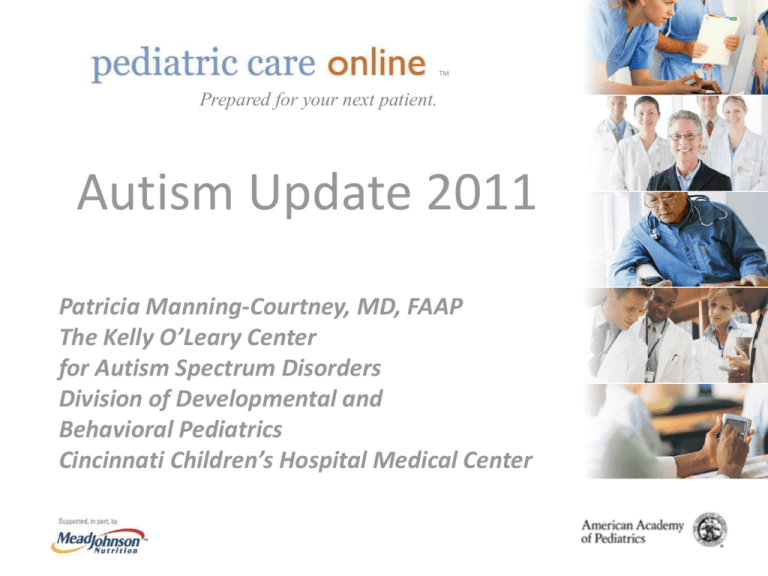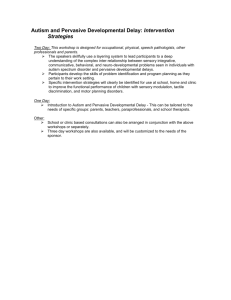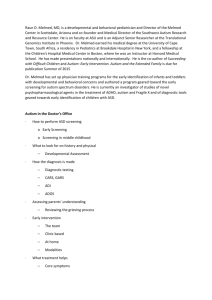
TM
TM
Prepared for your next patient.
Autism Update 2011
Patricia Manning-Courtney, MD, FAAP
The Kelly O’Leary Center
for Autism Spectrum Disorders
Division of Developmental and
Behavioral Pediatrics
Cincinnati Children’s Hospital Medical Center
TM
Disclaimers
Statements and opinions expressed are those of the authors and not
necessarily those of the American Academy of Pediatrics.
Mead Johnson sponsors programs such as this to give healthcare
professionals access to scientific and educational information provided by
experts. The presenter has complete and independent control over the
planning and content of the presentation, and is not receiving any
compensation from Mead Johnson for this presentation. The presenter’s
comments and opinions are not necessarily those of Mead Johnson. In the
event that the presentation contains statements about uses of drugs that
are not within the drugs' approved indications, Mead Johnson does not
promote the use of any drug for indications outside the FDA-approved
product label.
TM
Learning Objectives
Define and describe autism spectrum disorders
(ASDs).
Review epidemiology, demographics, and etiology.
Review screening and diagnosis recommendations.
Review treatment approaches.
Discuss current controversies.
TM
PERVASIVE DEVELOPMENTAL DISORDERS
Autism
Asperger
Syndrome
Rett
Syndrome
Childhood
Disintegrative
Disorder
Abbreviation: PDD-NOS, pervasive developmental disorder-not otherwise specified.
PDD-NOS
TM
TM
Changes in 2013…
Diagnostic and Statistical Manual of Mental Disorders, 5th
Edition (DSM-5) revisions
− Autism spectrum disorders
• Includes autism, Asperger syndrome, PDD-NOS, and child
disintegrative disorder (CDD)
− Concentrates on required features
• Social/communication deficits
• Restricted, repetitive patterns of behavior, interests, activities
o Addition of sensory criteria
− Increases specificity while maintaining sensitivity
• Important to distinguish spectrum from non-spectrum
developmental disabilities
• Improves stability of diagnosis
TM
DSM-5 Criteria:
Social Communication
Persistent deficits in social communication and social
interaction across contexts, not accounted for by
general developmental delays, manifested by all of
the following:
– Deficits in social-emotional reciprocity
– Deficits in nonverbal communicative behaviors
– Deficits in developing and maintaining relationships
appropriate to the developmental level
TM
DSM-5 Criteria:
Restricted/Repetitive Behaviors
Restricted, repetitive patterns of behavior, interests,
or activities as manifested by at least 2 of the
following:
– Stereotyped or repetitive speech, motor movements, or
use of objects
– Excessive adherence to routines
– Highly restricted, fixated interests that are abnormal in
intensity or focus
– Hyper- or hypo-reactivity to sensory input or unusual
sensory interests
TM
DSM-5 Criteria
Symptoms must be present in early childhood.
Symptoms together limit and impair everyday
functioning.
TM
What Else Can Look Like ASD?
Attention-deficit/hyperactivity disorder (ADHD) plus
anxiety
Nonverbal learning disability
Obsessive compulsive disorder
Anxiety plus language delay (with/without sensory
issues)
Cognitive delay plus anxiety
TM
Diagnostic Stability
Likelihood of stable diagnosis is high
– If diagnosed with autism at 2 years of age with standard
tests by highly experienced clinicians
If diagnosed with PDD-NOS at 2 years of age,
diagnostic shift is more likely, but still not common
– >10% shifted from PDD-NOS to out of spectrum
– 30% maintained PDD-NOS diagnosis at 9 years of age
– Most change occurred between 2 and 5 years of age
We may see more “shift” than is reported in this
study…
TM
TM
Epidemiology
Traditionally a rare disorder occurring in 4–5 per
10,000
Ratio of males to females unchanged (3–4:1)
Recent studies show 1% of all 8 year olds with an
ASD
Kogan MD, Blumberg SJ, Schieve LA, et al. The prevalence of parent-reported diagnosis of autism spectrum disorder among
children in the US, 2007. Pediatrics. 2009;124(5):1395–1403; Centers for Disease Control and Prevention. Prevalence of autism
spectrum disorders—autism and developmental disabilities monitoring network, United States, 2006. MMWR Surveill Summ.
2009;58(10):1–20.
TM
Epidemiology
Many studies rely either on parent report or school
record review.
Kogan study found that of people reporting their
child had received a diagnosis of ASD, 40% reported
their child no longer had ASD.
TM
A More Recent Study
Study in South Korea
– 1 in 38 children diagnosed with ASD (7–12 years of age)
– Collaboration with researchers at Yale Child Study Center
– Typical children and children in special education
participated in a 2 level screening/evaluation process
– A large number identified in typical schools
• 16% with intellectual disability
• 12% with superior intelligence
• 2/3 with milder form
Kim YS, Leventhal BL, Koh YJ, et al. Prevalence of autism spectrum disorders in a total population sample. Am J Psychiatry.
2011;168(9):904–912.
TM
Epidemiology
*Recent research has indicated that changes in diagnostic practices may account for at least 25% of the increase in prevalence
over time, however much of the increase is still unaccounted for and may be influenced by environmental factors.
©2009 Autism Speaks Inc. Autism Speaks and Autism Speaks It’s Time to Listen & Design are trademarks owned by Autism Speaks
Inc. All rights reserved.
TM
Changes in Prevalence of ASDs among
Children 8 Years of Age, 2002 to 2006
Abbreviation: ADDM, Autism and Developmental Disabilities Monitoring.
TM
Epidemiology
“True” increase or “epidemic?”
Increased awareness, broader diagnostic criteria,
diagnostic substitution…
Probably a little of both…
TM
Etiology
Unknown
– Initially described as a disorder of parenting/“refrigerator
mothers”
Neurobiologic disorder
Gene/environment interaction
Role of other systems
– Immune
– Gastrointestinal (GI)
TM
Genetics
Complex, yet strong genetic factors influencing
Strongest evidence from twin studies with 60% of
monozygotic twins concordant for full syndrome;
90% for related social or cognitive abnormalities
Risk of any form of PDD for sibling of proband with
autism as high as 5%
Relatives may be affected by difficulties that are
conceptually related to autistic behaviors (broader
autistic phenotype)
TM
TM
Recent Studies Suggest
Larger Environmental Role
Previous studies suggested strong genetic role
Current study looked at 192 twin pairs
– 54 identical, 138 fraternal
– Identical twins with 60–70% chance of dual diagnoses
– Fraternal twins with 20–30% chance of dual diagnoses
Two-fold increase risk for ASD when mother on a
selective serotonin reuptake inhibitor (SSRI)
Hallmayer J, Cleveland B, Torres A, et al. Genetic heritability and shared environmental factors among twins with autism. Arch Gen
Psychiatry. Online July 2011; Croen LA, Grether JK, Yoshida CK, et al. Antidepressant use during pregnancy and childhood autism
spectrum disorders. Arch Gen Psychiatry. Online July 2011.
TM
Screening for ASD
AAP recommendations
– Developmental surveillance at all well child visits
• Elicit parent concerns
– Developmental screening at 9, 18, and 30 (or 24) month
well child visits
• Use structured developmental assessment
– Screening for autism at 18 and 30 (or 24) month well child
visits
American Academy of Pediatrics Council on Children With Disabilities, Section on Developmental Behavioral Pediatrics, Bright
Futures Steering Committee and Medical Home Initiatives for Children With Special Needs Project Advisory Committee.
Identifying infants and young children with developmental disorders in the medical home: an algorithm for developmental
surveillance and screening. Pediatrics. 2006;118(1):405–420; Johnson CP, Myers SM, and American Academy of Pediatrics Council
on Children With Disabilities. Identification and evaluation of children with autism spectrum disorders. Pediatrics.
2007;120(7):1183–1215.
TM
This Just In!
Study in Pediatrics
– Recommended against routine screening due to lack of
solid support for screening based on traditional “rules” for
screening tools
– Excellent points made:
• Poor specificity of screening tools
• Lack of validated interventions
• Long wait lists
Still supportive of surveillance
Al-Qabandi M, Gorter JW, Rosenbaum P. Early autism detection: are we ready for routine screening? Pediatrics.
2011;128(1):e211–e217.
TM
Surveillance of ASDs
Direct observation/interactions/“clinical probes”
–
–
–
–
Pointing and directing child to “look” (12–15 months)
Calling child’s name (12 months)
Asking “Where’s mommy?”
Eye contact, gaze referencing, pointing—evidence of joint
attention
– Observe for unusual movements (looking at things closely,
out of corner of eye, repetitive movements, sensitivities)
TM
Surveillance of ASDs
Probing questions for parents:
– What is your child’s favorite toy/type of play? (12 to 18
months)
– Does your child babble? Wave bye-bye? Raise arms to be
lifted? Hear your voice as well as other things in the
environment? (9 to 12 months)
– Does your child have echolalia, “pop-up” words,
exceptional labeling? (12, 15, and 24 months)
TM
Surveillance of ASDs
“Development of social skills and language is more delayed
and characteristically ‘out of sync’ with motor, adaptive and
cognitive functioning.”
Johnson CP. Recognition of autism before age 2 years. Pediatr Rev. 2008;29(3):86–96.
TM
Screening Tools
No validated tools for use in children under 18
months
Level 1 screening tools for at risk or no risk children
– Checklist for Autism in Toddlers (CHAT)
– Modified Checklist for Autism in Toddlers (M-CHAT)
– Pervasive Developmental Disorders Screening Test-II
(PDDST-II)
No recommendation for screening school age
children
– Consider Social Communication Questionnaire
TM
M-CHAT
23 yes-no questions
Measures social reciprocity, language, some motor
18 months to 4 years of age
Detects ASD, language impairment, mental
retardation
Sensitivity/specificity
TM
M-CHAT and Autism Screening
Failing score if 2 or more critical items or any 3 items
are failed
Free download at www.firstsigns.org
2-page scoring guide
Takes 5 minutes to complete and 5 minutes to score
Autism screen recommended by AAP Autism Expert
Panel for use at 18–24 month well-child visit
TM
Diagnosis
Comprehensive, multidisciplinary evaluation
Autism Treatment Network Protocol
– Medical evaluation
– Psychological evaluation
– Autism Diagnostic Observation Schedule (ADOS), other
autism specific diagnostic tools
– Screening for common, related medical issues
• Sleep problems, GI problems
DSM-IV criteria insufficient
TM
Treatment: Getting Started
Speech/Language Therapy
– Picture Exchange Communication System
– Auditory Integration Therapy
Occupational Therapy
– Sensory Integration
Behavior Management
Early Intervention/Pre-School/School-Age
TM
TM
TM
Treatment:
More Intensive Approaches
Applied Behavioral Analysis
– Only “evidence based” intensive intervention
Son-Rise Program
Floor-time
Relationship Development Intervention (RDI)
Rapid Prompting Method (RPM)
TM
TM
Treatment: Teach
Treatment and Education of Autistic and Related
Communication Handicapped Children (TEACHH)
Statewide system of services for individuals with
autism and their families
Increase level of skill through adapting the
environment to accommodate the characteristics of
children with autism
TM
Treatment: Medical
Regular follow-up recommended
– Monitoring, screening of common medical issues
• Sleep issues, GI issues, nutritional concerns
– Medication management
Medications
Alternative medical treatments
TM
Medications
Target symptoms
–
–
–
–
–
–
–
–
Anxiety
Aggression
Obsessive/compulsive features
ADHD features
Sleep problems
Seizures
Mood lability
Repetitive behaviors
TM
Medications
Stimulants
SSRIs
Atypical antipsychotics
– Risperdal
Melatonin
Seizure medication
TM
Alternative Treatments
Diet
– Gluten and casein free diet
Vitamins
– B6, Mg, B12
– Super Nu Thera
Yeast treatments
Manipulation
Secretin, intravenous immune globulin (IVIG),
steroids, antivirals, chelation
TM
Autism and Vaccines
Currently no evidence to support a relationship
between vaccines and autism
Theories continue to change
Recent retraction of Lancet article
Families still “caught in the middle” between
research and media
TM
Retraction
Retraction—Ileal-lymphoid-nodular hyperplasia, nonspecific colitis, and pervasive developmental disorder
in children
Following the judgment of the UK General Medical Council’s Fitness to Practise
Panel on Jan 28, 2010, it has become clear that several elements of the 1998
paper by Wakefield et al1 are incorrect, contrary to the findings of an earlier
investigation.2 In particular, the claims in the original paper that children were
“consecutively referred” and that investigations were “approved” by the local
ethics committee have been proven to be false. Therefore we fully retract this
paper from the published record.
The Editors of The Lancet
The Lancet, London NW1 7BY, UK
1Wakefield
AJ, Murch SH, Anthony A, et al. Ileal-lymphoid-nodular hyperplasia, non-specific colitis, and pervasive developmental disorder in
children. Lancet. 1998;351:637–641.
2Hodgson H. A statement by The Royal Free and University College Medical School and The Royal Free Hampstead NHS Trust. Lancet.
2004;363:824.
TM
TM
Prognosis
Previous studies summarized:
–
–
–
–
10–15% with good outcomes
15–25% with fair outcomes
15–25% with poor outcomes
30–50% with very poor outcomes
Few current longitudinal studies exist
Issues of diagnostic “shift,” diagnostic stability
TM
TM
TM
TM
Resources
Autism Society of America −
www.autism-society.org
Autism Speaks – 100 Day Kit −
www.autismspeaks.org
Centers for Disease Control and Prevention −
www.cdc.gov
American Academy of Pediatrics −
www.aap.org
TM
For more information…
On this topic and a host of other topics, visit:
www.pediatriccareonline.org
Pediatric Care Online is a convenient electronic resource for immediate expert
help with virtually every pediatric clinical information need. Must-have resources
are included in a comprehensive reference library and time-saving clinical tools.
•
Haven't activated your Pediatric Care Online trial subscription yet?
It's quick and easy: simply follow the steps on the back of the card
you received from your Mead Johnson representative.
•
Haven't received your free trial card?
Contact your Mead Johnson representative or call 888/363-2362 today.








